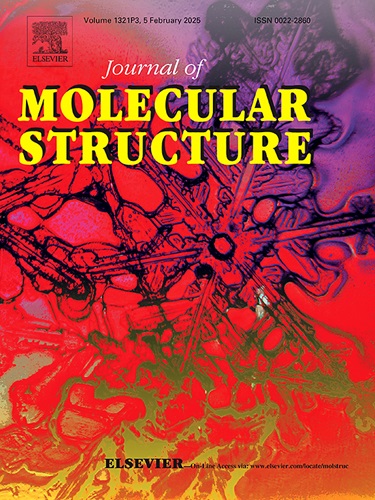Structure, fluorescence, solvent recognition and magnetic study of multi-functional carboxylic acid ligand hexacoordinate Eu, Tb and Dy complexes
IF 4.7
2区 化学
Q2 CHEMISTRY, PHYSICAL
引用次数: 0
Abstract
In order to better study the properties of rare earth complexes in terms of fluorescence, magnetism, and fluorescent probes, in this work, 5-(2-carboxyphenoxy)isophthalic acid (H3ocpia) and rare metal ions Eu3+, Tb3+, Dy3+ were used to synthetic metal complexes by solvothermal reaction. Then three complexes Eu(ocpia) (1), Tb(ocpia) (2) and Dy(ocpia) (3) were synthesized, their structural formulas are as follows: EuC15H7O7, TbC15H7O7 and DyC15H7O7. Data on the structure acquired via an X - ray single - crystal diffractometer indicates that complexes 1, 2, and 3 possess the same spatial structures. They are two-dimensional planar structures with undulating ripples. Moreover, solid - state fluorescence tests were carried out on complexes H3ocpia, 1, and 2, and magnetic property tests were done on complexes 2 and 3. Fluorescence recognition studies were conducted on complexes 1 and 2 in dispersed systems. The solid-state fluorescence results show that complexes 1 and 2 have excellent fluorescence properties, with higher fluorescence intensity than the ligand. The CIE chromaticity coordinates of complexes 1 and 2 are (0.59, 0.34) and (0.33, 0.62), respectively, and exhibit bright characteristic lights of europium and terbium under fluorescent lamps. Magnetic susceptibility measurements reveal that compounds 2 and 3 exhibit antiferromagnetic coupling behavior between adjacent metal centers. Fluorescence recognition studies have shown that complexes 1 and 2 exhibit good recognition of acetone in dispersed systems, the detection thresholds were determined to be 0.063 vol.% for complex 1 and 0.136 vol.% for complex 2.

多功能羧酸配体六配位Eu、Tb和Dy配合物的结构、荧光、溶剂识别和磁性研究
为了从荧光、磁性和荧光探针等方面更好地研究稀土配合物的性质,本工作以5-(2-羧基苯氧基)间苯二甲酸(H3ocpia)和稀有金属离子Eu3+、Tb3+、Dy3+为溶剂热反应合成金属配合物。然后合成了三个配合物Eu(ocpia)(1)、Tb(ocpia)(2)和Dy(ocpia)(3),它们的分子式为:EuC15H7O7、TbC15H7O7和DyC15H7O7。通过X射线单晶衍射仪获得的结构数据表明,配合物1、2和3具有相同的空间结构。它们是具有起伏波纹的二维平面结构。并对配合物H3ocpia、1、2进行了固态荧光测试,对配合物2、3进行了磁性能测试。在分散体系中对配合物1和2进行了荧光识别研究。固体荧光结果表明,配合物1和2具有优异的荧光性质,荧光强度高于配体。配合物1和2的CIE色度坐标分别为(0.59,0.34)和(0.33,0.62),在荧光灯下表现出明亮的铕和铽特征光。磁化率测量表明,化合物2和3在相邻金属中心之间表现出反铁磁耦合行为。荧光识别研究表明,配合物1和2在分散体系中对丙酮具有良好的识别能力,确定了配合物1的检测阈值为0.063 vol.%,配合物2的检测阈值为0.136 vol.%。
本文章由计算机程序翻译,如有差异,请以英文原文为准。
求助全文
约1分钟内获得全文
求助全文
来源期刊

Journal of Molecular Structure
化学-物理化学
CiteScore
7.10
自引率
15.80%
发文量
2384
审稿时长
45 days
期刊介绍:
The Journal of Molecular Structure is dedicated to the publication of full-length articles and review papers, providing important new structural information on all types of chemical species including:
• Stable and unstable molecules in all types of environments (vapour, molecular beam, liquid, solution, liquid crystal, solid state, matrix-isolated, surface-absorbed etc.)
• Chemical intermediates
• Molecules in excited states
• Biological molecules
• Polymers.
The methods used may include any combination of spectroscopic and non-spectroscopic techniques, for example:
• Infrared spectroscopy (mid, far, near)
• Raman spectroscopy and non-linear Raman methods (CARS, etc.)
• Electronic absorption spectroscopy
• Optical rotatory dispersion and circular dichroism
• Fluorescence and phosphorescence techniques
• Electron spectroscopies (PES, XPS), EXAFS, etc.
• Microwave spectroscopy
• Electron diffraction
• NMR and ESR spectroscopies
• Mössbauer spectroscopy
• X-ray crystallography
• Charge Density Analyses
• Computational Studies (supplementing experimental methods)
We encourage publications combining theoretical and experimental approaches. The structural insights gained by the studies should be correlated with the properties, activity and/ or reactivity of the molecule under investigation and the relevance of this molecule and its implications should be discussed.
 求助内容:
求助内容: 应助结果提醒方式:
应助结果提醒方式:


